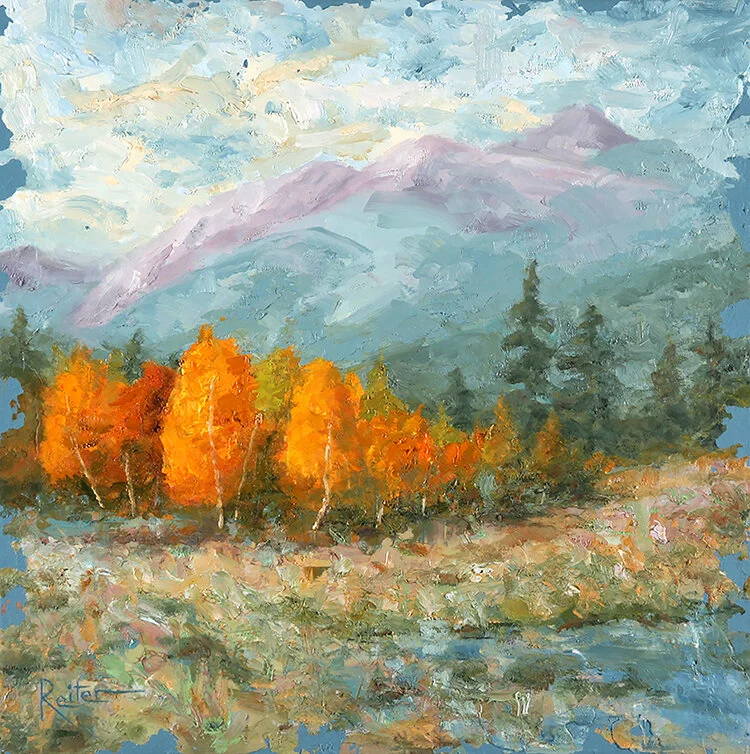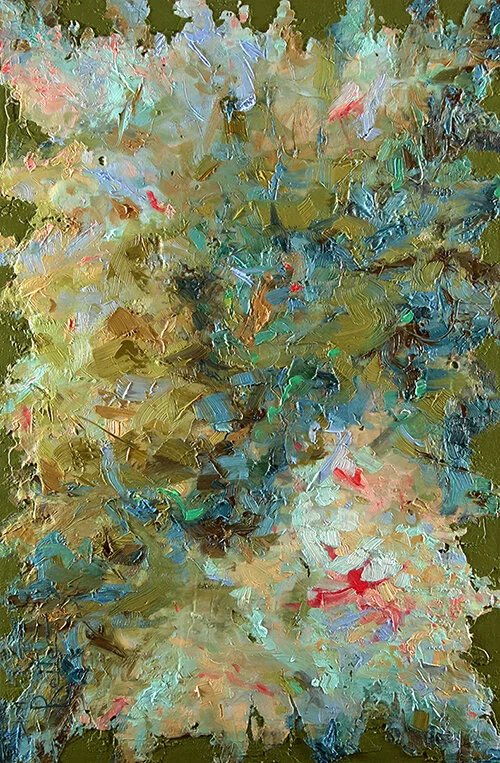Finding Inspiration (For Your Business)
I get asked all the time, “What was your inspiration for this painting?” People are intrigued, and I never get tired of sharing. It is fun to tell the stories, and as I do, I love to watch the way people draw connections between their lives and the paintings they see right in front of them. Many times, as I share about my inspiration behind specific pieces, I sense a longing from the people with whom I am talking. They, too, wish they could have greater moments of inspiration in their lives.
7 Inspirational Strategies For Creativity
Landscape by Dave Reiter “Restful Encounter”
1. Find a focus. There are four primary painting genres or categories: landscapes, portraits, still life, and abstract or non-objective. I mainly work in the landscape and abstract genres. I find inspirational focus for my landscapes by being out in nature.
2. Seek Other Forms of Art. For me, seeing other artists' paintings, sculptures, and other pieces of art inspires me.
3. Keep a child-like wonderment. I need to see the amazement in the simple things and take that into my paintings.
Abstract by Dave Reiter “Vibrant Beginnings”
4. Listen to music. When I listen to music, it inspires my body as I paint. Sometimes, words in a song can inspire a theme for a painting.
5. Watch movies. If I see something unique or creative in a film or video, it can inspire me to incorporate some visual element into my painting.
6. Actively engage in conversation. Bits and pieces of a conversation can inspire something creative in my mind or process.
7. Pay attention to words. Both spoken or written words have the ability to inspire me to try something new and different or to take a different approach with something I have already tried.
If I am always open, inspiration will hit me from a multitude of directions.(click to tweet this)
Six Strategies A Business Leader Can Use To Find Inspiration
“Rising Action”
You might not think of needing to find inspiration for your business, but people in business need continual inspiration to stay on the creative edge. In similar ways to an artist, companies can:
1. Identify your focus. Most companies have this, but you would be surprised at how many lose sight of it and wonder: who are we, what are we trying to do and for whom?
2. Get inspiration from what your competitors are doing. Keep yourself continually aware of what other similar businesses are doing. If those businesses are leading the industry, there is probably something you can learn from them.
3. Get inspiration from companies that aren't your competitors but are making a difference in their fields. As an artist, this involves getting inspiration from portrait artists even if I am painting a still life. In business, it might mean finding firms who operate in a different area than you but getting inspiration from their discoveries or processes.
4. Get inspiration from reading. If you aren't reading, you are missing out. Read Michael Hyatt’s has a great blog on 5 ways Reading Makes You A Better Leader.
5. Get inspiration from being in a creative culture and using the team's imagination to find new inspiration (see my blog Using Imagination to Boost Your Creativity).
6. Get inspiration by observing, especially in different environments. It takes an active decision to enter into the wonderment of a child. Yet, it opens you up to inspiration from many areas. It may even come from watching others do something you wish you could do.
Take A Field Trip
One activity that incorporates many of these principles into one exercise is taking a "field trip." You can take a field trip by yourself or go with a small team, which is often the best way to do it because you can talk to each other about what you observe. Remember when you were a child, and you went on a field trip? Why did your teacher take you? It was to learn something, to expand your horizon, and to expose you to something different.
Taking field trips with a business purpose is taking a trip for observation and inspiration. Examples could be:
Touring a highly successful business that is entirely different from your company.
Viewing something as simple as someone who is skydiving.
Going into a physical store with the intent of looking for something you can use in your business. You could look for a product to build, a process to incorporate, or some other idea that inspires you for your business. Doing something like this, rather than just reading about it, brings the possibility of enhanced inspiration because all five of your senses simultaneously gather information. I like to go into a store, any store, to do this. Many times, I get ideas that I incorporate into my paintings.
Walking through someone else's business and ask yourself questions. Utilize the Who, What, When, Where, Why, and How questions. In essence, you ask, "What can I learn from this encounter that can help me in my business?" You can evaluate the information later in a creative meeting with your team and decide if you want to implement it or not.
These field trips are experiences that can inspire you and help you to creatively connect dots in your business.
One final idea is for you to bring a problem your business is experiencing into these types of inspiring experiences. For example, your company might have a problem with customer service. So, you could walk through a store and ask yourself: Is there anything I can learn from how they treat their customers that would help me solve my business's customer service problem? This same concept applies to other challenges, such as in marketing, staffing, etc.
Don’t Wait For Creative Dry Spells To Motivate You
You can stay ahead of the creative game. You don't have to wait for creative dry spells to motivate you to action. If you regularly implement the suggestions in this blog, it will keep the creativity well flowing. Or, if your business has already lost the creative edge, you can refill the creative well by taking one or two of these principles and putting them into practice regularly. Keep in mind that the creative well is dry because it has nothing in it. These ideas will help keep the well full.
Don't stop doing these things when you get one idea. Keep adding to your creativity well. Record your ideas. You can also read my blog for part two, "Staying Creatively Full." Maybe one day, someone will ask you as they ask me, "Where did you find your inspiration?"
What do you do to find inspiration? Share your comments below.
Until next time, find the inspiration and keep the creative edge.
Want more creative tips: sign up for my weekly blog post & art updates
Other great articles I found beneficial are:
Aaron Hall “The Field Trip: Get Your Creative Juices Flowing With One Easy Step”
John Boitnott “25 Simple Ways for Entrepreneurs to Find Inspiration”
Philip VanDusen has a great video on “7 Ways to Find Inspiration” but you can also go to his website for other great tips philipvandusen.com
Related Articles:
Share This




